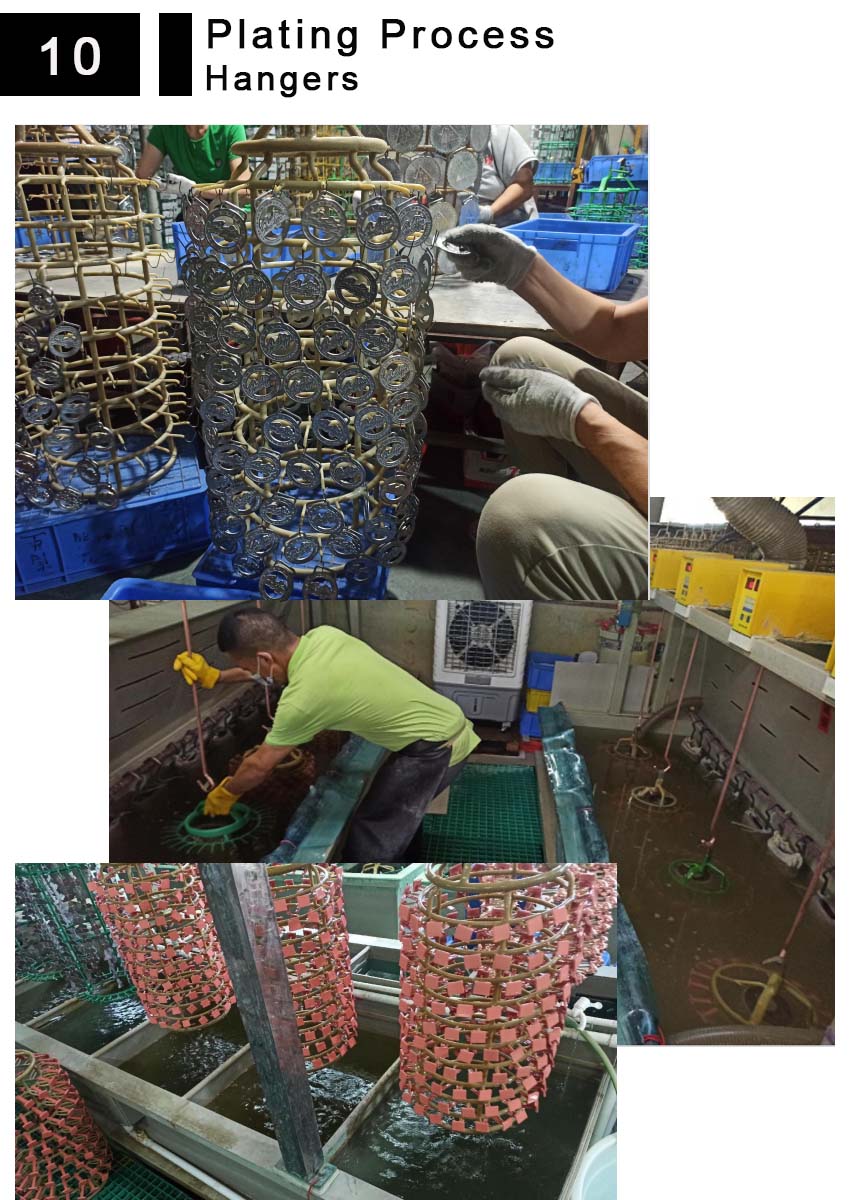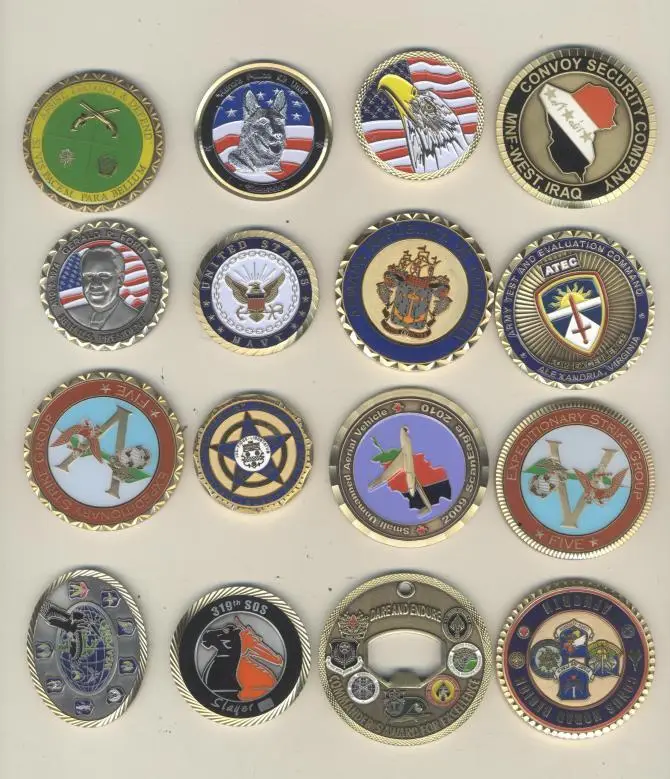Description
1. Purpose
In electroplating production, hangers mainly serve to conduct electricity, support, and fix parts. They are connected to electrodes to ensure uniform current transmission to the parts during electroplating.
2. Auxiliary Tool
Plating Hanger
3. Working Principle
Based on the size and shape of the badges, hangers of different specifications and models are used to ensure the products are evenly placed on the hangers.

hangers
What Are the Hangers Used in Electroplating for Badges Custom?
In the world of custom badge manufacturing, electroplating plays a critical role in ensuring the final product has a professional, durable, and high-quality finish. Electroplating is the process of applying a metal coating, usually gold, silver, or nickel, to a base material. The choice of the correct hangers in the electroplating process is essential to achieving precise, uniform coatings on badges. In this article, we will dive deep into the importance of hangers used in electroplating for custom badges and provide you with detailed information about different types, their specifications, and commonly asked questions.
What are Electroplating Hangers?
Electroplating hangers are specialized tools used to hold and suspend custom badge designs in an electrolytic bath during the electroplating process. The primary purpose of these hangers is to ensure that the badges remain submerged in the bath while maintaining a consistent and uniform coating. The design and material of the hangers must meet specific criteria to ensure the electroplating process is efficient, and the resulting badges meet the desired specifications.
Electroplating hangers are made from materials that do not interfere with the electroplating process and are capable of handling the weight of the badges. They need to be resistant to corrosion and oxidation, as they are repeatedly exposed to chemicals in the plating bath.
Types of Electroplating Hangers
There are several different types of electroplating hangers, each with its unique features tailored to specific manufacturing needs. Let’s explore some of the most commonly used hangers in custom badge electroplating:
1. Single Hook Hangers
- Description: These are the most basic type of hangers, consisting of a single hook designed to hold one badge at a time. The hook suspends the badge in the electrolytic bath, ensuring a uniform coating.
- Materials: Stainless steel, nickel-plated steel.
- Applications: Used in small-scale production or when dealing with a single design.
- Advantages: Simple, cost-effective, and easy to use.
- Disadvantages: Limited capacity, not suitable for high-volume production.
2. Multi-Hook Hangers
- Description: Multi-hook hangers can hold several badges simultaneously, making them perfect for large-scale electroplating operations. These hangers are designed with multiple hooks arranged in a manner that ensures all badges receive an equal plating.
- Materials: Stainless steel, titanium, or nickel-plated steel.
- Applications: High-volume badge production.
- Advantages: Increased efficiency, can plate several badges at once.
- Disadvantages: Slightly more expensive and more complex than single hook hangers.
3. Bar Hangers
- Description: Bar hangers use a horizontal bar to which multiple badges are attached. These are perfect for larger badges or designs that need a more uniform plating process.
- Materials: Stainless steel or titanium.
- Applications: Custom badge electroplating where large batches of badges need to be plated uniformly.
- Advantages: Cost-effective for large batches, improved efficiency.
- Disadvantages: May be less precise in holding badges compared to individual hook hangers.
4. Rotary Hangers
- Description: Rotary hangers are designed to rotate the badges within the electroplating bath, providing a uniform coating on all surfaces of the badge.
- Materials: Stainless steel or high-quality plastic.
- Applications: Electroplating of complex or multi-faceted custom badges.
- Advantages: Provides even coating on all surfaces.
- Disadvantages: More expensive and requires additional equipment.
5. Custom Hangers
- Description: For specialized badge shapes or sizes, custom hangers are designed to fit the specific requirements of a production run. These can be tailored to hold irregularly shaped badges securely during plating.
- Materials: Typically stainless steel or specialized alloys.
- Applications: Unique, custom-designed badges that require specific handling.
- Advantages: Perfect fit for unique designs, ensures a high-quality finish.
- Disadvantages: Higher cost due to customization.
Key Specifications to Consider
When selecting the right hangers for electroplating badges, it’s important to consider several factors that affect both the plating quality and the operational efficiency. Here are the key specifications to look for:
| Specification | Description |
|---|---|
| Material | Hangers are typically made from stainless steel, titanium, or nickel-plated steel due to their corrosion resistance. |
| Weight Capacity | Ensure the hanger can handle the total weight of the badges being plated without bending or breaking. |
| Size & Shape | The hanger should be appropriately sized for the badges, ensuring they are suspended in the bath without touching each other. |
| Durability | High-quality materials will resist wear and tear, ensuring long-lasting performance. |
| Chemical Resistance | The hanger material must withstand the chemicals used in the electroplating process, including acids and alkaline solutions. |
How Electroplating Hangers Affect Badge Quality
The use of high-quality hangers in the electroplating process is critical for producing custom badges that meet both aesthetic and durability standards. Improper or low-quality hangers can result in inconsistent plating, poor adhesion, and even contamination. Here’s how hangers influence the final product:
- Uniformity of Plating: The hangers ensure that the badges are evenly suspended in the bath, promoting uniform plating across all surfaces.
- Plating Thickness: Proper hanger design ensures that the plating thickness is consistent, which is crucial for the longevity and visual appeal of the badge.
- Surface Finish: High-quality hangers prevent badges from touching or overlapping, which can cause uneven finishes or blemishes.
Frequently Asked Questions
1. What are the different types of electroplating hangers used for badges?
Electroplating hangers come in several types, including single hook hangers, multi-hook hangers, bar hangers, rotary hangers, and custom hangers. Each type serves a different purpose based on the scale of production and the complexity of the badges being plated.
2. Why is material selection important for electroplating hangers?
The material of the hangers is crucial because it must be resistant to corrosion, wear, and the chemicals used in the electroplating process. Common materials include stainless steel, titanium, and nickel-plated steel, as they are known for their durability and resistance to chemicals.
3. How do electroplating hangers affect the quality of the custom badges?
Electroplating hangers play a key role in ensuring uniform coating, plating thickness, and overall quality. If the hangers do not properly suspend the badges, it can lead to inconsistent plating, which affects the durability and appearance of the final product.
Conclusion
Electroplating hangers are a fundamental aspect of the custom badge manufacturing process. By choosing the right type of hanger and ensuring they meet all necessary specifications, manufacturers can achieve consistent, high-quality results. Whether you’re producing badges in small quantities or scaling up for large production runs, the right hangers can make all the difference in the success of your electroplating process. Understanding these hangers’ role and selecting the best materials and designs will ensure that your custom badges not only look great but also stand the test of time.








